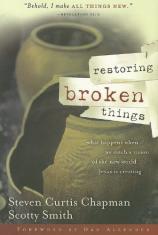Restoring Broken Things: What Happens When We Catch a Vision of the New World Jesus Is
Review
Restoring Broken Things: What Happens When We Catch a Vision of the New World Jesus Is
This book's subtitle aptly describes its content: "What Happens When We Catch a Vision of the New World Jesus is Creating." Steven Curtis Chapman (known for his song writing, his singing, and increasingly for his humanitarian vision) and Scotty Smith, pastor of a megachurch in Franklin, Tennessee --- a star-lit suburb of Nashville --- have teamed up to present a thought-provoking look at the purpose and mission of individual Christians and the corporate church. Unlike some "collaborations," Chapman and Smith maintain separate voices throughout the book, each providing both theological content and personal stories.
RESTORING BROKEN THINGS has its anecdotal, inspirational moments. Chapman, for example, spends most of a chapter, "Restoring Broken Relationships," recounting the story of Steve Saint's now-close relationship with the Ecuadorian tribesman who murdered his father, Nate, in 1956. And Smith, sometimes quoting from journal entries, walks us through the painful journey of a ten-day "marriage retreat" (though, he says, "it felt more like we'd been on the set of ER"), in which he discovered and faced his own inner brokenness.
But overall this is not a lightweight book. With diagrams and theological analysis and teaching, it delves into the redemptive story that has two bookends: the first two chapters of Genesis and the last two chapters of Revelation, in which Jesus says, "Behold, I am making all things new!" Smith says, "Jesus has the lead role in God's Story. But He's not the only character.
"He's making us characters too. We are carriers of God's Story...
"We are called into a story that enfolds our own stories in a grander narrative --- a story that is going somewhere, a story that is taking us with it." As we understand our brokenness and Christ's work of grace, we become increasingly available to God as agents of change, agents of restoration.
Chapman and Smith have a view of history and Scripture that is more classic and simple than a fundamentalist dispensationalism. Their diagrams illustrate our being in an "already and not yet" age, bridging the time before Christ to the "new heaven and new earth" described in Revelation.
Some of the book's more interesting material challenges a contemporary understanding of the meaning of worship as being that which happens in church, before the sermon. Chapman and Smith have a broader view --- that worship includes and leads to service. (The "device" used to present his material --- Smith in dialogue with and lecturing a seminary class, centering on Jesus' John 4 discussion about those who worship "in spirit and in truth" --- feels a little forced but does help to engage a lay reader.)
A "Conclusion" section that is not billed as a last chapter starts with a heart-wrenching report from Sri Lanka, after the 2004 tsunami. It then turns to what is admitted to be a Smith sermon, reflecting on such horrific devastation in light of various passages in 2 Corinthians, in which the apostle Paul repeatedly uses a "so that" construction. X happened so that Y might be accomplished. "By doing this, Paul modeled the important difference between asking the self-centered question, 'Why me, Lord?' versus asking the God-centered question, 'What now, Lord?'"
How can we work with God to restore the brokenness in our lives, in our homes, in our churches, in our culture? That is the book's question. And it is full of thought-provoking answers.
Reviewed by Evelyn Bence on October 20, 2005
Restoring Broken Things: What Happens When We Catch a Vision of the New World Jesus Is
- Publication Date: October 20, 2005
- Genres: Christian, Christian Living
- Hardcover: 224 pages
- Publisher: Thomas Nelson
- ISBN-10: 1591452805
- ISBN-13: 9781591452805



